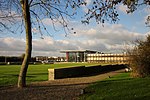Ram Hill Colliery
Bristol CoalfieldBuildings and structures in South Gloucestershire DistrictCoal mines in GloucestershireUnderground mines in EnglandUse British English from February 2023

Ram Hill Colliery, (grid reference ST679803) was a privately owned colliery in the Coalpit Heath area north-east of Bristol, England. It operated between about 1825 and 1865.
Excerpt from the Wikipedia article Ram Hill Colliery (License: CC BY-SA 3.0, Authors, Images).Ram Hill Colliery
Broad Lane,
Geographical coordinates (GPS) Address Nearby Places Show on map
Geographical coordinates (GPS)
| Latitude | Longitude |
|---|---|
| N 51.520433 ° | E -2.46407 ° |
Address
Broad Lane
Broad Lane
BS36 2UA
England, United Kingdom
Open on Google Maps









